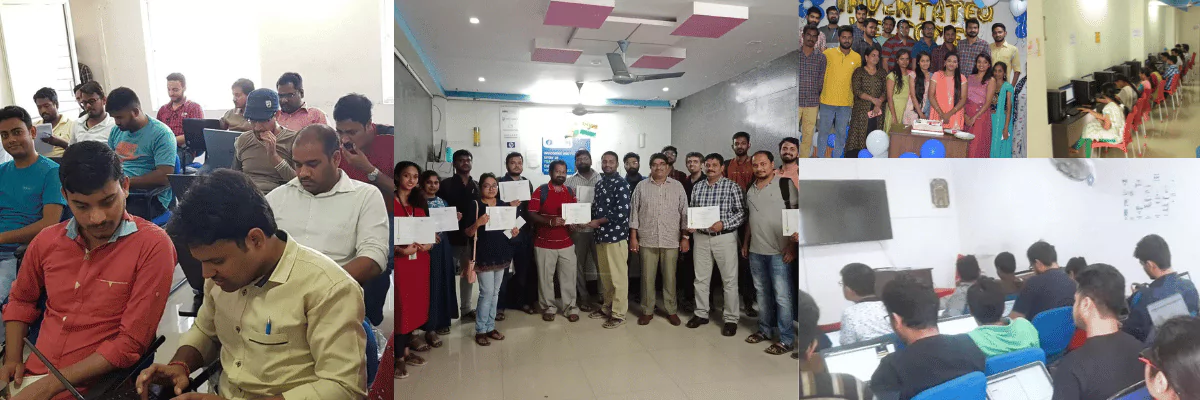Best Python Training
in Bangalore with Placement Guaranty
Our Python Training Course in Bangalore is designed to equip you with essential Python Full Stack programming skills. Whether you are a beginner or looking to enhance your expertise, this Python Full stack Developer course offers comprehensive knowledge and hands-on training in Python.
- 100% Job Oriented Python classes taken by Industry Professionals
- Resume & Interview Preparation to make you Job Ready
- Assured Job Support till you get placed
- Real Time Projects to Practice

24,999₹
- Certifications:
12 Authorised
- Batches:
3 Weekly
- Projects:
10+ Live
- Assignments:
21+ Practicals
Free 1 Hour Training Session!
Get Job with our Guaranteed Placement
Support Program
How we have placed 10,579 Students in Python?







Tanisha Sharma
20 LPA • Digital Marketing


Nikita Jain
15 LPA • Sales


Kirandeep
15 LPA • Application Testing


Manikanta Saladi
40 LPA • Cloud AWS Engineer


Koushiki Iyer
12 LPA • Social Media Marketing


Kirshna Gowtham
15 LPA • Developer


Rakesh Reddy
15 LPA • Salesforce Developer


Kisori Venu Mondal
10 LPA • Executive Sales


Nandini Iyer
20 LPA • Cloud Developer


Nandini Gowtham
20 LPA • Digital Marketing


Kandrikala Rajshekhar
14.6 LPA • Python Developer


Setty Sivalingham
12.4 LPA • Software Engineer


Deborshi Rudra Laxmi
10 LPA • Digital Marketing


Shaik Shaheed
6.5 LPA • Junior Data Scientist


Sirish Kumar
14.3 LPA • Digital Strategist Lead


Laxmi Roy
16 LPA • Backend Developer


Sahil Kumar
20 LPA • Marketing


Nehusu Siva Prasad
16.5 LPA • Oracle Developer


Nandini Jainar
14.8 LPA • Developer


Sahana
9.2 LPA • Data Science


Jaya Rai
10 LPA • Digital Marketing


Sunil Kumar
10.5 LPA • Marketing


Rahul Mahajain
7 LPA • Java Developer


Vikas
12 LPA • Python Developer


Hari Krishna
13 LPA • Software Engineer


Vibhu Rajesh
3.3 LPA • Full Stack Developer


Sweta Reddy
15 LPA • Product Marketing


Anwar Basha
27.2 LPA • Data Analytics Lead


Why we are the best?
We are India's No.1 Python Training Institute in Bangalore.
- Online & Offline Classes by Professionals
- Live Classes Led by Top IIT Instructors
- Regular Job Updates & 100% Placement Support
573
Courses
6937
Students
170
Instructors
12
Certificates

Inventateq Offline Batches
Our offline batch provides an immersive learning environment with face-to-face interaction. Students benefit from direct guidance from trainers, networking opportunities with peers, and a structured schedule that fosters discipline and focus in mastering Python programming.
Bangalore | Bangalore | Chennai- Dedicated Classes & Batches
- Safe & Easy Environment for Learning
- 100+ Python Instructors are here

Inventateq Online Live Classes
Our online course offers flexibility and convenience, allowing you to learn Python from anywhere. With recorded sessions and live classes, you can revisit materials at your own pace while still engaging with instructors and classmates through interactive platforms.
- 100% Instructor Led Online Classes
- Dedicated and Best Doubt Solving
- Guides, PDFs, PPTs and Exam Guidance
- Backup Classes nd Recordings
Why Inventateq Python Training Course is Best?
Internship & Practical Experience
Our Python Training Course in Bangalore includes internships that provide real-world experience. Students work on live projects, gaining practical skills that are essential for a successful career in software development. This hands-on approach enhances learning and prepares students for industry challenges.
Hands-On Practical Training
The course emphasizes hands-on practical training, ensuring that students can apply theoretical knowledge to real-world scenarios. With numerous coding exercises and projects, learners develop confidence in their Python skills, making them job-ready upon course completion.
Resume Building Guidance
We offer personalized resume-building guidance to help students effectively showcase their skills and experiences. Our trainers assist in crafting resumes that highlight Python proficiency and relevant projects, increasing the chances of securing interviews with top employers.
Interactive Live Classes
Our interactive live classes promote active participation and engagement. Students can ask questions in real-time, collaborate on projects, and receive immediate feedback from instructors, creating a dynamic learning atmosphere that enhances understanding of Python concepts.
Aptitude & Technical Skills
The course includes training in aptitude and technical skills necessary for software development roles. Students will engage in problem-solving exercises and coding challenges that sharpen their analytical thinking and technical abilities, preparing them for competitive job markets.
Mock Tests & Quizzes
Regular mock tests and quizzes are conducted to assess students' understanding and retention of Python concepts. These assessments help identify areas for improvement, ensuring that learners are well-prepared for both course evaluations and real-world applications.
Expert Guidance Every Step
Our experienced trainers provide expert guidance throughout the course. With years of industry experience, they offer insights into best practices, career advice, and mentorship, ensuring that students receive comprehensive support as they navigate their learning journey.
Community Discussions
Students are encouraged to participate in community discussions, fostering collaboration and knowledge-sharing. These discussions create a supportive environment where learners can exchange ideas, troubleshoot coding issues, and build a professional network within the Python community.
Guaranteed Job Placement
We are committed to providing guaranteed job placement assistance for our graduates. Our dedicated placement team connects students with leading companies, helping them secure positions that match their skills and career aspirations in the field of Python programming.
Employee Referral Program
Our employee referral program allows graduates to tap into our extensive network of industry partners. By connecting with employees at top companies, students can gain insights into job openings and increase their chances of landing desirable positions in the tech industry.
Featured Hiring Partners
We partner with prominent companies in the tech sector, providing students with access to exclusive job opportunities. Our featured hiring partners actively seek Python-trained candidates, ensuring that our graduates are highly sought after in the job market.
Exclusive Job Postings
Graduates receive access to exclusive job postings tailored for Python professionals. Our team curates listings from top employers, ensuring that students are informed about the latest openings that align with their skills and career goals.
The Best Interactive Learning experience in Bangalore Batch
Our Python Training Course in Bangalore offers a rich learning experience that combines theoretical knowledge with practical application. Students engage in real-world projects, collaborate with peers, and receive personalized feedback from experienced trainers, ensuring a comprehensive understanding of Python programming.

Why Students choose our Python Training Course in Bangalore?
Bangalore, known as the Silicon Valley of India, is a hub for technology and innovation. The city boasts a thriving IT industry, providing ample job opportunities for Python developers. By choosing to learn in Bangalore, students gain access to a vibrant tech community and numerous networking possibilities.
Why Inventateq Courses Only?
Inventateq is a leading Python training institute in Bangalore, known for its high-quality education and successful placement record. Our expert trainers, comprehensive curriculum, and hands-on training approach set us apart, ensuring that students are well-prepared to excel in their careers.
Inventateq's Python Training in Bangalore is designed to provide in-depth knowledge of Python programming with practical, hands-on experience. Our expert trainers ensure a comprehensive learning experience to help students excel in Python-based roles across industries.
- Comprehensive coverage of Python fundamentals and advanced concepts.
- Real-world projects on web development, data analysis, and machine learning.
- Hands-on practice with Python libraries like NumPy, Pandas, and Matplotlib.
- Expert guidance on working with APIs, databases, and version control systems.
- Practical exposure to frameworks like Flask and Django.
- Placement assistance and career guidance from industry experts.
Through this course, students will gain a strong foundation in Python programming and advance their skills with hands-on projects and practical use cases. The curriculum is tailored to meet the demands of the evolving tech landscape.
- Master Python fundamentals, including variables, data types, and operators.
- Develop proficiency in control flow, functions, and modules.
- Learn object-oriented programming and file handling techniques.
- Explore data structures like lists, dictionaries, and sets, along with algorithms.
- Get introduced to web frameworks like Flask and Django for web development.
- Analyze data using NumPy and Pandas, and create visualizations with Matplotlib and Seaborn.
- Understand machine learning basics and work with Scikit-learn.
- Master version control with Git and learn to collaborate effectively.
Inventateq's Python Training in Bangalore is tailored to provide both foundational knowledge and advanced skills in Python programming. Our curriculum is crafted by industry professionals to ensure students are job-ready upon course completion.
With access to live projects, personalized mentoring, and flexible learning options, our course is suitable for beginners and experienced professionals. Placement support and certification add significant value to your learning journey.
Inventateq's Python Training is open to anyone looking to excel in Python programming. Whether you're starting from scratch or enhancing your existing skills, this course is your gateway to a successful career in tech.
- Students and graduates seeking to build a career in programming.
- Professionals aiming to upskill in Python and related technologies.
- Entrepreneurs looking to automate workflows using Python.
- Individuals preparing for Python certification exams.
- Data enthusiasts eager to explore data analysis and visualization.
Enrolling in Inventateq's Python Training in Bangalore is simple. Join our free 1-hour demo session to understand the course structure, training methodology, and career prospects.
Experience live demonstrations of real-world projects and learn how this course can help you achieve your career goals.
Sign up now for a free demo session!
Have any doubts about our Python Training?
Have any questions about our Python Training course? Don’t hesitate to reach out! Our dedicated support team is available to clarify course details, certification requirements, and enrollment processes. We’re here to help you on your learning path!
What Our Brilliant Learners have achieved?
Join countless learners who have achieved career advancement and success in Python
Training through Inventateq's
renowned courses in Bangalore. Elevate your skills and career prospects with us today!
95% Placement Rate
Our Python Training Course in Bangalore boasts an impressive 95% placement rate. This statistic reflects our commitment to equipping students with the skills and knowledge that employers seek. With a strong focus on practical training and industry connections, we help students secure rewarding job placements in leading companies.
2000+ Industry Partners
We have established partnerships with over 2000 industry leaders, providing students with access to exclusive job opportunities and internships. These connections enhance our curriculum and ensure that our training aligns with current industry demands, giving our graduates a competitive edge in the job market.
500+ Courses
Inventateq offers a diverse range of over 500 courses, including specialized training in Python programming. Our extensive course catalog allows students to choose from various topics and skill levels, ensuring that they find the right program to meet their career goals.
40% Average Salary Hike
Graduates from our Python Training Course in Bangalore experience an average salary hike of 40%. This increase is a testament to the high demand for Python skills in the job market and the effectiveness of our training in preparing students for lucrative positions in the tech industry.
90% Growth Rate
Our institution has achieved a remarkable 90% growth rate, reflecting the increasing recognition of our training programs in the industry. As more students seek to enhance their skills in Python and other technologies, we continue to expand our offerings and improve our training methodologies.
₹12 LPA Average Salary
The average salary for our graduates from the Python Training Course in Bangalore is ₹12 LPA. This competitive salary highlights the value of our training and the demand for skilled Python developers in the job market, making our course a worthwhile investment for aspiring professionals.
YOUR INSTRUCTOR
Miraya Rao
Over 8+ Years experience in Zenlayer
Meet Miraya Rao, a seasoned Python developer with over 10 years of experience in software development. She holds a Master's degree in Computer Science and has worked with top-tier companies, leading projects that utilize Python for data analysis and machine learning. Her passion for teaching and extensive knowledge makes her an invaluable asset to our training program.

Certification for Python Training Course in Bangalore.
Completing our Python Training course grants you a certification that validates your knowledge of various Python modules and applications. This credential positions you as a qualified professional in enterprise resource planning (ERP), significantly enhancing your career opportunities in organizations that rely on Python solutions for their business processes.

Inventateq Course Completion
Earn this certificate upon successful completion of our Python Training Course in Bangalore.

NASSCOM Python Certification
Obtain this NASSCOM certification, validating your expertise in Python programming for software development and data solutions.

Data Analysis Certification
Achieve this globally recognized certificate by mastering data manipulation and visualization using Python libraries like Pandas and Matplotlib.

Web Development Certification
Earn this certification to showcase your proficiency in developing robust web applications using Flask and Django frameworks.

Machine Learning Certification
Gain this certification by learning fundamental machine learning techniques and libraries like Scikit-learn and TensorFlow.

Database Management Certification
This certification validates your expertise in handling databases and performing efficient queries using Python and SQL.

API Integration Certification
Showcase your skills in integrating and managing APIs using Python, leveraging tools like Requests and JSON.

Version Control with Git Certification
Highlight your proficiency in version control using Git and managing collaborative projects efficiently.

Advanced Python Certification
Demonstrate your expertise in object-oriented programming, exception handling, and advanced Python concepts with this certification.

Software Development Certification
Show your skills in Python-driven software development and building scalable applications.
Join Inventateq Career Guidance Program.
Launch your fastest career with Inventateq! Our program equips you with in-demand skills to unlock insights from big data and land your dream job. Join us and become a career hero!
What are the best Python Training Institutes in Bangalore?
When searching for the best Python training institutes in Bangalore, it's essential to consider factors such as course content, trainer expertise, placement assistance, and student reviews. Some of the top institutes include Inventateq, which is renowned for its comprehensive Python training course in Bangalore. The institute offers a well-structured curriculum that covers both foundational and advanced topics in Python programming. Additionally, Inventateq provides hands-on training, allowing students to work on real-world projects, enhancing their practical skills. The trainers at Inventateq are industry experts with years of experience, ensuring that students receive quality education. Furthermore, the institute has a strong placement record, with many graduates successfully securing jobs in leading tech companies. Other notable institutes include Simplilearn, Edureka, and Jigsaw Academy, each offering unique programs tailored to different learning needs. It's advisable to visit the institutes, attend demo classes, and read testimonials to make an informed decision. Ultimately, the best institute will align with your career goals and provide the necessary support to excel in the field of Python programming.
What is the cost of Python Training in Bangalore?
The cost of Python training in Bangalore varies depending on the institute, course duration, and additional features offered. On average, you can expect to pay between ₹15,000 to ₹40,000 for a comprehensive Python training course. Institutes like Inventateq provide competitive pricing while ensuring high-quality training. The course fees often include access to study materials, live projects, and placement assistance, making it a worthwhile investment for aspiring programmers. It's important to compare the offerings of different institutes to ensure you receive value for your money. Some institutes may also offer flexible payment plans or discounts for early registrations, making it easier for students to manage costs. Additionally, consider the potential return on investment, as completing a Python course can significantly enhance your employability and lead to higher salary prospects in the tech industry. Ultimately, the cost of Python training should be viewed in the context of the quality of education and career opportunities it provides.
Which Python modules are in high demand in Bangalore?
In Bangalore's thriving tech ecosystem, several Python modules are in high demand among employers. Key modules include Pandas for data manipulation and analysis, NumPy for numerical computations, and Flask or Django for web development. These modules are essential for roles in data science, machine learning, and web development. As companies increasingly rely on data-driven decision-making, proficiency in data analysis libraries like Pandas and NumPy is crucial for data analysts and scientists. Additionally, web frameworks such as Flask and Django are sought after for developing robust web applications. Other popular modules include TensorFlow and Keras for machine learning, as they enable developers to build and deploy AI models effectively. Students enrolled in Python training courses should focus on mastering these modules to enhance their job prospects in Bangalore's competitive job market. By gaining hands-on experience with these libraries, learners can demonstrate their skills to potential employers and stand out in the hiring process. Overall, staying updated with industry trends and focusing on high-demand Python modules will significantly boost career opportunities in Bangalore.
Can I get Python certification in Bangalore after completing the training?
Yes, upon completing the Python training course in Bangalore, students can obtain certification that validates their skills and knowledge in Python programming. Institutions like Inventateq offer certification to students who successfully complete the course, including assessments and projects. This certification serves as a valuable addition to your resume and demonstrates your proficiency in Python to potential employers. Many companies prefer hiring candidates with recognized certifications, as it indicates a level of commitment and expertise in the field. The certification process typically includes a final exam or project assessment to ensure that students have grasped the essential concepts of Python programming. Additionally, some institutes may provide industry-recognized certifications that enhance your credibility in the job market. By obtaining a Python certification, you increase your chances of securing job interviews and can command higher salaries in the tech industry. Therefore, completing a Python training course and obtaining certification is a strategic move for anyone looking to establish a successful career in software development or data science in Bangalore.
What is the duration of Python courses offered in Bangalore?
The duration of Python courses offered in Bangalore varies based on the institute and the specific program structure. Typically, full-time courses range from 4 to 12 weeks, while part-time or weekend courses may extend up to 6 months. For example, Inventateq offers a comprehensive Python training course that lasts for 8 weeks, including both theoretical and practical sessions. The course is designed to accommodate the needs of working professionals and students, providing flexibility in learning. Additionally, some institutes offer advanced courses or specializations that may take longer to complete, depending on the depth of content covered. It's essential to choose a course duration that aligns with your learning goals and availability. Shorter courses may focus on core concepts, while longer programs often include additional projects and advanced topics. Ultimately, the duration of the course should be considered alongside the quality of training, support provided, and the opportunity for hands-on experience in Python programming.
Are there any placement opportunities after Python Training in Bangalore?
Yes, there are numerous placement opportunities available for students after completing Python training in Bangalore. Institutes like Inventateq have established strong connections with leading tech companies, facilitating job placements for their graduates. The placement assistance program includes resume building, interview preparation, and job referrals to help students secure positions in the industry. Many companies actively seek Python-trained candidates due to the increasing demand for software developers and data scientists. Graduates can expect to find job openings in various sectors, including IT, finance, healthcare, and e-commerce. Additionally, Inventateq's collaboration with over 2000 industry partners enhances the chances of students landing interviews with reputable organizations. The institute regularly organizes job fairs and networking events, providing students with direct access to potential employers. By completing a Python training course, students not only gain valuable skills but also increase their employability in a competitive job market. Therefore, pursuing Python training in Bangalore opens up a wealth of placement opportunities for aspiring professionals.
Is online Python Training available in Bangalore?
Yes, online Python training is widely available in Bangalore, catering to students who prefer flexible learning options. Many institutes, including Inventateq, offer comprehensive online courses that cover the same curriculum as their offline counterparts. These online courses include live classes, recorded sessions, and interactive assignments, allowing students to learn at their own pace. The virtual format enables learners to connect with experienced trainers and peers, fostering collaboration and engagement despite geographical limitations. Online training is particularly beneficial for working professionals or those with busy schedules, as it allows them to balance their commitments while acquiring new skills. Additionally, students can access a wealth of online resources, including coding exercises, projects, and quizzes, to reinforce their learning. By choosing online Python training in Bangalore, students can benefit from high-quality education without the need for commuting. This flexibility, combined with the rigorous curriculum and expert guidance, makes online Python training an attractive option for aspiring programmers.
What are the prerequisites for joining Python Training in Bangalore?
Joining a Python training course in Bangalore typically requires minimal prerequisites, making it accessible to a wide range of learners. A basic understanding of programming concepts is beneficial but not mandatory. Most institutes, such as Inventateq, welcome beginners who are eager to learn Python from scratch. Familiarity with fundamental computer skills, such as using a text editor and navigating the command line, can enhance the learning experience. Some courses may recommend knowledge of basic mathematics, as programming often involves logical reasoning and problem-solving. However, these prerequisites are not strict, and instructors are prepared to support students who may need additional assistance. The primary requirement is a willingness to learn and a commitment to completing the course. By fostering a supportive learning environment, institutes ensure that all students, regardless of their background, can successfully grasp Python programming concepts. Therefore, prospective learners should not hesitate to enroll in a Python training course in Bangalore, as the curriculum is designed to accommodate various skill levels.
Who are the top trainers for Python in Bangalore?
Bangalore is home to several top trainers specializing in Python programming. Many experienced professionals and industry experts lead training programs at renowned institutes like Inventateq. These trainers bring a wealth of knowledge and practical experience, ensuring that students receive high-quality education. Notable trainers often hold advanced degrees in computer science or related fields and have worked with leading tech companies. Their expertise covers a wide range of topics, from basic Python syntax to advanced frameworks like Django and Flask. Additionally, top trainers emphasize hands-on training, guiding students through real-world projects that enhance their learning experience. Many of these trainers are passionate about teaching and mentoring, providing personalized support to help students succeed. By learning from industry veterans, students gain valuable insights into best practices and current trends in Python programming. This exposure not only enhances their technical skills but also prepares them for successful careers in the tech industry. Therefore, enrolling in courses led by top trainers in Bangalore is a strategic choice for aspiring Python developers.
How does Python Training in Bangalore compare to other cities in India?
Python training in Bangalore is often regarded as one of the best in India due to the city's vibrant tech ecosystem and numerous educational institutions. Compared to other cities, Bangalore offers a unique combination of experienced trainers, industry connections, and a diverse range of courses. The city is home to many leading tech companies, providing ample job opportunities for Python developers, which attracts both students and trainers. Additionally, Bangalore's innovative environment fosters collaboration and networking among professionals, enhancing the overall learning experience. Other cities, such as Hyderabad and Pune, also offer Python training; however, Bangalore's status as the Silicon Valley of India gives it a competitive edge. Students in Bangalore benefit from exposure to cutting-edge technologies and trends, as many startups and established companies are headquartered here. Furthermore, the availability of offline and online training options allows learners to choose programs that suit their needs. Overall, Python training in Bangalore stands out for its quality, industry relevance, and potential for career growth.
Book Free Demo Class.
Get a free demo class for the desired course you loves to continue with Inventateq.





